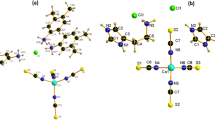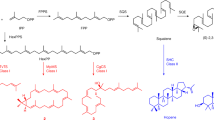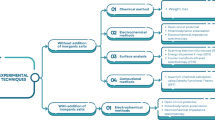Abstract
IN 1952 the existence of two thiocyanato-complexes of composition (PPrn3)2Pt2Cl2(SCN)2 was reported1. The labile α-isomer had m.p. 144°–152° and the stable β-isomer, m.p. 173°–174.5°. These isomers have dipole moments of less than 2 Debye units and so must have the tri-n-propylphosphine groups in trans-positions to each other. Possible structures are (I), (II) and (III).
This is a preview of subscription content, access via your institution
Access options
Subscribe to this journal
Receive 51 print issues and online access
$199.00 per year
only $3.90 per issue
Buy this article
- Purchase on SpringerLink
- Instant access to full article PDF
Prices may be subject to local taxes which are calculated during checkout
Similar content being viewed by others
References
Chatt, J., and Hart, F. A., Nature, 169, 673 (1952).
Penney, W. G., and Sutherland, G. B. B. M., Proc. Roy. Soc., A, 156, 654 (1936).
Langseth, A. L., Nielsen, J. R., and Sørensen, J. O., Z. phys. Chem., B, 27, 100 (1934).
Author information
Authors and Affiliations
Rights and permissions
About this article
Cite this article
CHATT, J., DUNCANSON, L. Use of the Infra-Red Spectrum to distinguish Bridging from Terminal Thiocyanato-S-Groups in Co-ordination Compounds. Nature 178, 997–998 (1956). https://doi.org/10.1038/178997a0
Issue date:
DOI: https://doi.org/10.1038/178997a0
This article is cited by
-
Copper(I) complexes of nitrogen-sulphur ligands. 1-Phenyl-4,6-dimethylpyrimidine-2-thione and its protonated form as ligands in copper(I) complexes. Chemical, spectroscopic, conductivity and polarographic studies
Transition Metal Chemistry (1988)
-
Heterogeneous reactions of solid nickel(II) complexes. XVIII
Journal of Thermal Analysis (1983)
-
Coordination compounds of manganese(II) with 1,10 phenanthroline
Journal of Thermal Analysis (1979)
-
Doppelkomplexsalze des Thioharnstoffs und der Thiocyanat-Ionen mit den Übergangsmetallen Cd(II), Cu(II) und Co(II)
Monatshefte für Chemie - Chemical Monthly (1977)
-
Doppelkomplexsalze von Co(II), Ni(II) und Cu(II) mit Thioharnstoffliganden im Kationkomplex und Thiocyanatliganden im anionkomplex
Monatshefte f�r Chemie (1976)



